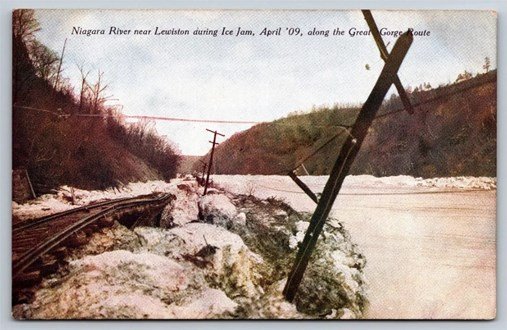In last month’s ATP we read about the Niagara ice jam of 1909. This month we will learn a bit more about this cataclysmic event and its effect on Stella Niagara and our neighbors.
The present generation had never beheld such a condition on the river. Old rivermen said that there had not been anything like it since 1844, not even in the Spring of 1863, when the old Suspension Bridge at Lewiston went down before the wind after being weakened by the ice.
Hundreds of people from Buffalo and other parts of Western New York and visitors from other parts of the country were drawn to Niagara Falls by the sights offered by the unusual ice jam, and to accommodate the crowds the International Railway Company was obliged to put on a special service from Niagara Falls, N.Y. to Queenstown on the Canadian side, and return, thus offering to visitors a chance to travel the length of the ice jam without bother or inconvenience.
After a few days it became apparent that the river was fast rising and again menacing property along its shores. It became necessary to remove much property to higher land in order to save it from destruction. The situation was alarming until the ice began to move out, but it soon became lodged on a sandbar near the mouth of the river and docks that had been dry and filled with spectators became submerged in water. For an entire day a force of men consisting of every one available worked diligently removing boats, fishing tackle, and other property to a place of safety. An old lady living near the river was rescued from her house after the water had covered the floor of her home. Boat houses and docks all along the river were wholly or partly under water.
At Lewiston much anxiety was manifested on account of the encroachments of the water and ice. A huge boulder of the ice stood at the back of Cornell’s Hotel and the building was considered to be in danger. The props were swept from under the veranda of the Ritz Hotel. Other houses were vacated and buildings moved back to keep them from being torn to pieces by the ice and water. The ice was heaped many feet high on either side of the river and the mounds of ice rose at various points near the center. At Queenston and Niagara-on-the-Lake similar conditions prevailed—entrance to a number of buildings at these places was cut off by the water. The repair work that had been commenced along the Gorge had been undone, the tracks newly submerged by nearly twenty feet of water. Further work would be useless until conditions changed.
The governor, after receiving an urgent appeal from the citizens of Youngstown and Lewiston, took up the matter with the State Superintendent of Public Works and decided at once to do something to relieve the situation.
Two experts in the use of explosives were sent to the scene of the trouble to render any assistance in their power. The men made their investigation and reported at Buffalo when two thousand pounds of dynamite were loaded on wagons and sent to the mouth of the river where the blasting was begun.
In our orchard, the water was so high that only two feet of the trees were visible but we place our confidence in St. Anthony, the great helper in all needs. Every evening all the members of the Novitiate took a trip to the water’s edge and said the responsory of St. Anthony nine times and sprinkled holy water around. The great wonder-worker did not delay long in helping us for after three days our land was visible while that of our neighbor was still under water. Now, the damages were discovered, three to five feet of bank had been washed away and the trees near the coast line were uprooted. Divine Providence favored us though, for while other people suffered from the damage done to their aqueducts, ours was left unharmed.
Note: At that time the orchard was in the meadow below the hill and the water supply for the convent and school was drawn from the river and pumped up the hill to the storage reservoir behind the laundry and power house.

